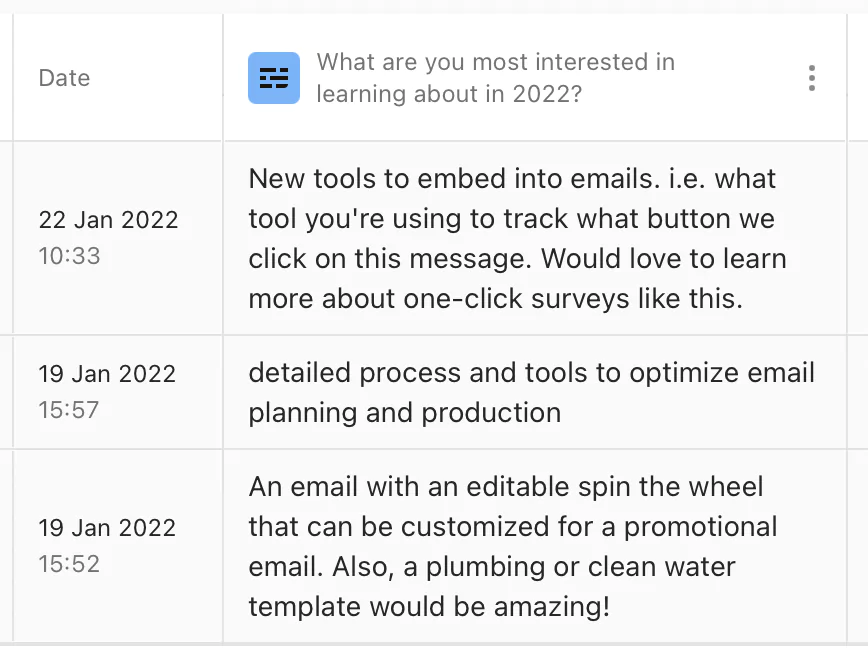11 Email Marketing Experts Tell us What They Learned in 2021 and How It’s Shaping Their 2022 Email Strategy
February 7, 2022 14 min read

2021 was not your average year. So much happened globally, and those global happenings changed the way we live, work, and do business. A lot of companies had to shift their approach to selling, and with so many events and networking opportunities canceled, we had to get more creative with our outreach and relationship-building efforts.
On top of that, there were shifts made so that consumer privacy was more protected and controlled. This meant that marketers had to get more innovative with methods they used to learn about their customers, leads, and potential leads.
So, what do all these shifts mean for email marketing this year? We asked X experts to provide us with their biggest 2021 lessons that they’ll be using to inform their email marketing strategies this year. Take a look at what they had to say.
1. Focus on Essential Metrics for Success
Alex Souchoroukof, Digital Marketer for Moosend

The pandemic brought many changes in the email marketing world, and 2021 was no exception. The most crucial lesson for me was the Apple Mail Privacy Protection (MPP) update.
What is the significance of this update? When Mail Privacy Protection is turned on, it pre-loads email content and activates the tracking pixel which used to track open rates. This means that the open rate is no longer an accurate metric of success, especially if your email list has a substantial number of Apple Mail users.
As a result, other metrics like click-through rate and conversion rate will be more critical in 2022. While many email marketers were disappointed by this update, many believe Apple’s update pushed marketers to focus on more essential metrics of engagement.
Indicators like conversions and clicks can help organizations optimize campaigns for results that have a more significant financial impact. This brings me to the second takeaway from 2021.
Businesses often look at email marketing as another channel for their marketing efforts. Although this might be true, Moosend took this channel to another level in 2021 and used it as connective tissue between other channels.
By aligning all channels, businesses can maintain consistency and give a seamless experience regardless of the form of communication used. As a result, a social media post can become a quick newsletter, and a webinar can become a whole campaign that will guide leads in your marketing funnel.
Email marketing is a vital tool that organizations can use in 2022 in tandem with other channels to skyrocket their success and increase their revenue into unprecedented numbers.
2. Put Your Audience First
Liviu Tanase, Founder and CEO of ZeroBounce

The most important thing we learned is that caring about your audience will always pay off. Trends come and go, and email marketing is always changing, often causing businesses to panic.
For instance, Apple’s Mail Privacy Protection wasn’t good news for anyone. But if you look at most industry updates, they all have one goal in common: to give people a better experience with email. Sometimes, that means finding new ways to measure our success. Not focusing on vanity metrics but on actual results while offering our audience the best interaction with our brand – isn’t that a win-win?
In 2021, we took even more steps into audience research so we could better tailor our emails to each group. Our focus was to further customize the content to respond to people’s needs at the right time. It’s too early yet to determine the results. We’re still fine-tuning our approaches, but we know this is better for our customers and prospects.
In 2022, you have to go that extra mile to show your audience that you care. Show up with the most relevant response to what they’re looking for, and you’ll see conversions increase.
Another critical aspect we noticed in 2021: 30% of our database went bad. Seeing this much data go obsolete in just one year was shocking even for us, as an email validation company!
B2B email lists churn a lot faster now because the job market is so unstable. We validate our contacts more often now and recommend our customers do the same. When you have a healthy list, you have peace of mind knowing your emails are more likely to go to the inbox.
3. Don’t Be Afraid to Test….and Test Some More
Jaina Mistry, Senior Email Marketing Manager, Litmus

While there’s considerable value in applying best practices to your email marketing, it’s not the end of the journey or the definitive answer. It’s the starting point. Testing and learning (on repeat!) is the only way to truly understand what works for your audience. For example, we tested animated GIFs in some of our emails to see if they improved click-through rate (CTR) and conversions. We found that they didn’t actually help us–but we’re not stopping there. We’ll test again, on different audiences and in different campaigns, before we reach any conclusions.
We’re also exploring whether traditional “rules” around how to communicate with a certain type of audience still apply. While we’re primarily in the B2B space at Litmus, we’re still emailing humans. We’re committed to showing empathy in our emails and making sure that our messages connect with our audience on a human level. To do that, we’ll experiment with different approaches to design, copy, content–and even emojis in subject lines–to see what resonates.
This year, we’re also challenging how we do things internally. We’re embarking on an Agile marketing pilot to become more customer-focused and to identify (and eliminate) the bottlenecks that slow us down. That means exploring (and again, testing!) what processes and systems of prioritization make sense for the business we’ve become–and the one we are striving to be. So many marketers are being asked to do more (often with the same amount, or fewer, resources). It’s important not to underestimate how powerful tweaking or changing a process or workflow could be to productivity, outcomes—and employee fulfillment and satisfaction.
4. Incorporate Data, Automate, and Use an Omnichannel Approach
Parul Shukla, Associate Director Digital & Brand Marketing at Email Uplers

Email, undeniably, is the most promising marketing channel, and this fact was only re-established in 2021. But the year also taught us some valuable lessons, which are surely going to guide our email marketing strategy for 2022. Let’s take a look at three such aspects:
Incorporate Data Meaningfully for Targeted Marketing
Targeted marketing became the talk of the email town in 2021, laying even more emphasis on two primary strategies – segmentation and personalization. In 2022, we’ll be pushed to use zero and first-party data meaningfully to understand our subscribers better so that we can reach each one of them with the right message at the right time and thus deliver a great user experience.
Get Organized by Automating Your Campaigns
We all know that brand building and recall are two of the primary goals of email marketing, and they can be achieved through uninterrupted, personalized, and timely communication with subscribers. While managing such communication manually can be a herculean task, it can be achieved easily through the strategic use of data and automation. So, it’s time to get organized and automate campaigns. A dedicated CRM system will prove to be truly helpful in this regard.
Make Way for Omnichannel Experiences
Your subscribers are now connecting with your brand via various channels – email, SMS, social media, website, app, etc. So, do not depend and focus on just one channel. You need to adopt an omnichannel approach to deliver a consistent experience across channels. Omnichannel campaigns are about constantly updating and tweaking messaging on all platforms in response to user activity. So, whatever channel subscribers choose to engage with, they’ll enjoy a personalized experience.
In a nutshell, we need to keep the subscriber top of mind in 2022. We’re creating emails to get them to engage with the brand, so every communication must focus on what they expect from the brand and not the other way round.
5. Get Comfortable With the Unknown
Jennifer Nespola Lantz, VP of Industry Relations and Deliverability at Kickbox

2021 made any email marketer that felt complacent about their program stop in their tracks. Between BIMI at Gmail, Apple’s MPP, security breaches, and the loss of cookies (oh wait, that hasn’t happened yet), email marketing is about to come out of its cocoon, again.
As you approach 2022, be ready to get comfortable with the unknown, try new things, and revisit the old things.
Authentication
Authentication is often swept aside because it’s technical or it’s been in place forever. New email authentication protocols don’t roll out often. But when they do, you want to make sure you are not only aware of them, but you are adapting to them.
If you don’t yet have it, implement DMARC. If you do, check your email authentication results and SPF, DKIM, and DMARC records and make sure they are as protective as possible. You don’t want lingering DNS entries tied to old platforms, either. They can either create confusion during authentication or keep you open to compromise.
Testing
Turn your program into an R&D department and start testing. Find out what works and what doesn’t based on how your goals are impacted. Discover what metrics (new and old) are needed to measure them.
So if the ultimate goal is a click, website traffic post-launch is a better indicator of success than the once high-held open. If list growth is your KPI, try moving your opt-in form to the top.
Privacy and Data Protection
Look at what your signup forms are conveying and what permission you are actually getting. Move from opt-out to opt-in and include unsubscribe options on all emails.
Utilize forms, surveys, preference pages, loyalty programs, etc., to collect data directly from your customers as well as actions within your site and purchase behavior.
Finally, spend time focusing on your internal systems. There’s no privacy if there is a breach. 2FA, hashing, captcha, and increased admin control are things you can do to protect your system, your customers, and your lists.
6. Personalization is Key
Mariia Kovalenko, Content Strategist, and Editor at Digital Marketer’s World

Personalization is definitely something that I will stick to in 2022.
In the past year, especially towards the end, I got so many emails from potential clients and partners that were obviously templates they reused for every person they were reaching out to. On some occasions, they even called me by a different name, which is a brutal mistake in this day and age. All this experience inspired me to write an entire article on email marketing examples where I talk a lot about personal approach to the recipient.
So, I highly recommend researching the prospect prior to writing your message. For example, you could go to their LinkedIn page, check out the latest post or comment they made, and use it as a point to start a conversation.
Also, make sure you’re reaching out to the right person. If you are interested in building a partnership, the person you’re contacting should be the decision-maker responsible for it. Otherwise, the risk of your email ending up in the spam folder is just too high, and who wants that?
So, to sum up, get to know the addressee before emailing them and personalize your message.
7. Show Your Audience That You Care
Andre Oentoro, CEO and Founder of Breadnbeyond

From several lockdowns to more time spent online to new pandemic variants in 2021, I’ve learned that people have now become attached to brand messages that focus on or talk about personal health and wellbeing– including through email marketing campaigns. Last year, I noticed an uptick in brands talking about self-care, setting digital boundaries, and taking breaks in my own inbox on social media feeds.
We also decided to send some email newsletters that promote the importance of physical health and encourage self-care or simply show that our brand cares about our prospects. And we found out that those types of emails had higher open and response rates.
That’s why in 2022, there’ll be more conversations surrounding our jobs or well-being and how it affects us. An emphasis on mental health and even burnout prevention in this year’s email marketing campaign would be a friendly and light-hearted way to engage today’s busy, fickle, often-frustrated prospects.
When it comes to email marketing, the message we send can come off more personal as you can personalize and tailor the message to our prospects.
In other words, our 2022’s email marketing campaigns should no longer be solely focused on bombarding offers or bragging how awesome the new features are, how competitive the price is, or a whole explanation of how bad prospects will need it. Instead, it’s time to show how we are incorporating the health and wellness culture. We believe that when we can make our prospects feel valued and cared about, we have a higher chance to increase email marketing conversion rates.
That said, one thing to keep in mind here is that we should know the limit. We make sure not to go overboard with the message because it can scare prospects away or at least make them uncomfortable. Simply including a short, brief copy in your marketing emails to remind prospects to take care of themselves should work just fine.
8. Stop Pushing Products
Jeremy Moser, Co-Founder of uSERP

The biggest thing we learned about email marketing in 2021 that will inform our 2022 strategy is keeping our ask risk-free. In other words, especially as a service-based business, we’ve found it critical to just initiate real conversations rather than pushing products, sales, and discounts. People rarely convert on services from a single email. Decisions take time, and multiple people often have to buy in. To match this, we look to write conversation-starting emails and provide genuinely helpful suggestions that build trust and relationships over time.
9. Prioritize Your Email List and Save Time
Jordie van Rijn is an Email Marketing Consultant and MarTech enthusiast with emailmonday.

People used to say, “The money is in the list.” Sounds sexy, but that is only part of it. It is actually “The power is in the list.” A strong email list will stack the deck in your advantage for partnerships, co-promotion, SEO, product innovation, new client growth, loyalty, etc., etc.
Growing, nurturing, and enriching your email list is where most companies can see the biggest jump in outcomes after they got all the basics in place. There are 101 ways to make your email list grow, but most marketers don’t prioritize it.
All things the same, 10% new subscribers can represent way more than 10% growth in results. Especially in eCommerce, when engagement and results are slanted towards new subscribers.
Crafting highly targeted, audience-specific lead magnets and landing pages is a great way to grow your list. You may not even need to do completely separate content. Replace as little as 10%, and it will feel fully targeted. With the right landing page optimization tools, there are a lot of different ways to optimize your landing pages:
- Use automated a/b testing
- Use AI-based text suggestions
- Ask for user feedback on the page
- Record user sessions and clicks, etc.
- Look at how your Landing pages render on mobile
Optimizing your pages for list growth is definitely a tactic to consider this year.
Also, review your email production time. Take a close look at how much time you are spending on each task, writing text, designs, etc. A quick win is to start using only templates. There is a place for custom coding an email master template, but with thousands (not kidding) of free email templates available to inspire and use, it is well within reach for every budget. You can easily adjust templates to fit your newsletter template branding. And these work perfectly with almost any email software, like Benchmark Email, for instance.
10. Gather Reader Insights with Surveys
Sophia Shalabi, Email Marketing Strategist at BEE Content Design

Last year, BEE experimented with one-click email surveys and polls. These tripled our CTOR (from ~3% to over 9%). This year, we’ll continue to leverage this strategy to open up conversations with our email list.
The biggest takeaway: email doesn’t have to be a one-way communication channel. These one-click surveys help us get a pulse on what our readers are thinking about and how they are reacting to our content.
This is how it works:
Step 1: Choose a question. For our latest email, we wanted to know what readers were interested in learning about this year.
Step 2: Choose your answers. It’s best to have “shortcut” answers (aka pre-determined, multiple choice answers) that customers can simply click to log their vote. We also included an “other” option, where people could type in their answers.
Step 3: Set up your UTMs and surveys. The first three links were UTMs that went to a “thank you” landing page. We were able to track how many people clicked on each answer, thus calculating the results of the poll.
The “other” CTA went to a Typeform, where we gathered answers.

Step 4: Track the results. Data is everything! We’ll use both the quantitative and qualitative data to shape our future emails and blog content.

Step 5: Iterate. That’s the life of an email marketer. Always optimizing from what we’ve learned. Happy 2022!
11. Be Nimble
Chris Donald, Director of InboxArmy

Always be nimble and quick to change strategy based on what the customer is doing and how their buying habits are influenced by outside sources.
In the summer of last year, the whole supply-chain issue moved front and center, affecting everything, including the holidays. Toys, iPhones, electronics, etc. were going to be in low supply. We saw Amazon and Walmart starting what were essentially Black Friday sales in Late September and October, so we pivoted our strategy for our eCommerce clients to start the big sales around the same time. It was a win across the board. If our teams hadn’t kept an ear to the ground about what was happening in the space, sales would have been lost. Most of our eCommerce clients had record September and October sales and still had excellent November sales.
Buying habits pivot quickly for a multitude of reasons and the data doesn’t always tell you this until it’s too late. So make sure you pay attention to trends and how they can influence your business.
The best way to move on from 2021 is to take the lessons we learned and apply them to this coming year, and the same can be said for email marketing. We hope these expert tips come in handy as you take a hard look at your email strategy this year. Cheers to better email marketing and a successful 2022!



